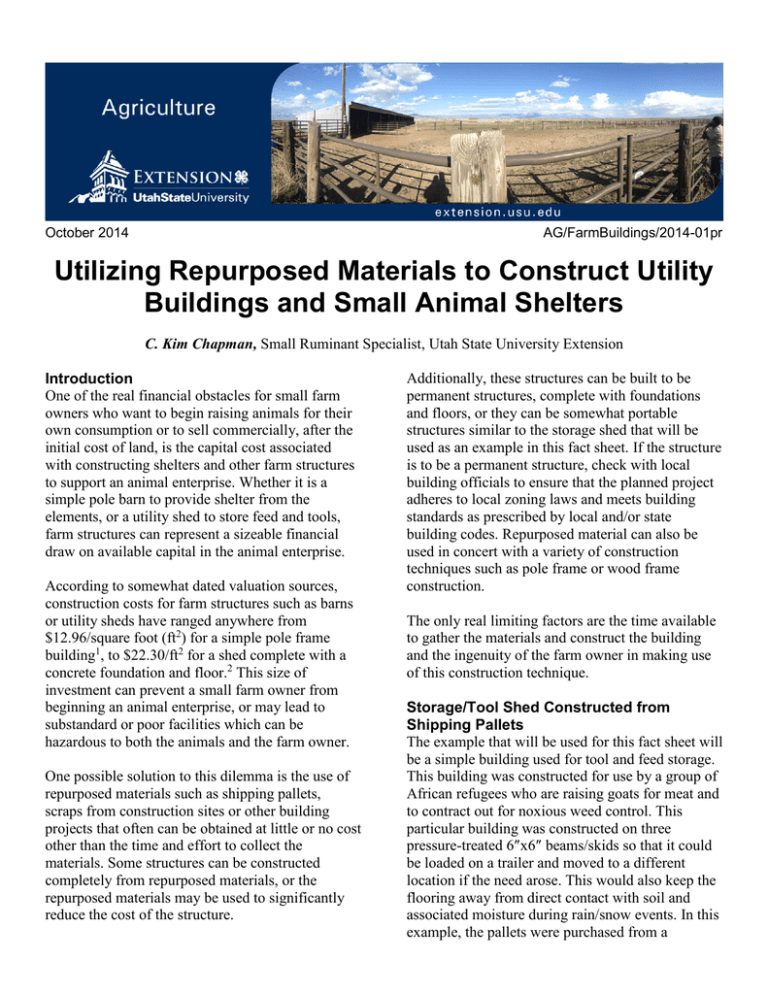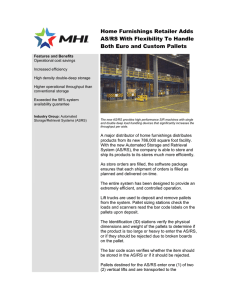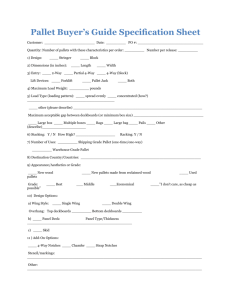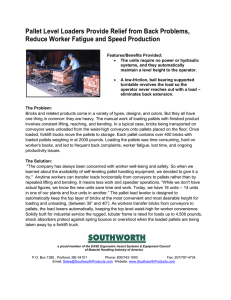Utilizing Repurposed Materials to Construct Utility Buildings and
advertisement

October 2014 AG/FarmBuildings/2014-01pr Utilizing Repurposed Materials to Construct Utility Buildings and Small Animal Shelters C. Kim Chapman, Small Ruminant Specialist, Utah State University Extension Introduction One of the real financial obstacles for small farm owners who want to begin raising animals for their own consumption or to sell commercially, after the initial cost of land, is the capital cost associated with constructing shelters and other farm structures to support an animal enterprise. Whether it is a simple pole barn to provide shelter from the elements, or a utility shed to store feed and tools, farm structures can represent a sizeable financial draw on available capital in the animal enterprise. According to somewhat dated valuation sources, construction costs for farm structures such as barns or utility sheds have ranged anywhere from $12.96/square foot (ft2) for a simple pole frame building1, to $22.30/ft2 for a shed complete with a concrete foundation and floor.2 This size of investment can prevent a small farm owner from beginning an animal enterprise, or may lead to substandard or poor facilities which can be hazardous to both the animals and the farm owner. One possible solution to this dilemma is the use of repurposed materials such as shipping pallets, scraps from construction sites or other building projects that often can be obtained at little or no cost other than the time and effort to collect the materials. Some structures can be constructed completely from repurposed materials, or the repurposed materials may be used to significantly reduce the cost of the structure. Additionally, these structures can be built to be permanent structures, complete with foundations and floors, or they can be somewhat portable structures similar to the storage shed that will be used as an example in this fact sheet. If the structure is to be a permanent structure, check with local building officials to ensure that the planned project adheres to local zoning laws and meets building standards as prescribed by local and/or state building codes. Repurposed material can also be used in concert with a variety of construction techniques such as pole frame or wood frame construction. The only real limiting factors are the time available to gather the materials and construct the building and the ingenuity of the farm owner in making use of this construction technique. Storage/Tool Shed Constructed from Shipping Pallets The example that will be used for this fact sheet will be a simple building used for tool and feed storage. This building was constructed for use by a group of African refugees who are raising goats for meat and to contract out for noxious weed control. This particular building was constructed on three pressure-treated 6″x6″ beams/skids so that it could be loaded on a trailer and moved to a different location if the need arose. This would also keep the flooring away from direct contact with soil and associated moisture during rain/snow events. In this example, the pallets were purchased from a company that refurbishes and sells pallets to area manufacturing companies and were quite inexpensive since these pallets were considered less marketable due to their odd size. There are several methods that can be used to construct a building out of pallets. The pallets can be used “as-is” as demonstrated in this example, or they can be disassembled and the components can be used in a conventional framed structure. The pallets were secured to each other using ordinary 2″x4″x8′ dimension lumber which allowed the pallets to be attached to adjacent pallets in both directions on the flat plane (Figure 1). This was accomplished using 5″x1/4″ lag screws. Once connected together the entire floor infrastructure was then secured to the beams using 6″x3/8″ lag screws inserted diagonally (toenailed) into the beams. To further strengthen the floor, 3/4″ oriented strand board (OSB) subfloor material was secured to the topside of the pallets as the “finished” floor of the structure. Once the floor is complete, the long walls are built by laying pallets on the floor and using the same method used to tie the floor pallets together with the 2″x4″ lumber and 5″ lag screws. A 2″x4″ board is attached to what will be the bottom and top of the wall to provide further rigidity to the wall. These will serve as the bottom and top plates, similar to normal framed wall construction. When both long walls are complete, they can be erected either using a lift or by several people standing them manually (Figure 2). Once in place, use a level to check each wall to ensure it is plum. Attach braces to both ends of the wall and along the interior of the wall if it is more than about 12′ in length. This keeps it plum while securing it to the floor and until the ends are completed and in place. Attach the wall to the floor by driving screws through the bottom plate and into the floor structure. In areas where high winds can be problematic, metal “hurricane clips” such as those seen in Figure 3 can be used to further secure the wall to the floor structure and to secure the roof to the walls. After the long walls are installed, the end walls can be built and installed, much like the long walls. Depending on the building dimensions partial pallets or dimension lumber may be used to fill in any space to make the end wall fit the space between the two long walls. One end wall of the building shown in this example has the entrance door built into it (Figure 3). This wall was a hybrid, constructed partially of pallets while the other half, which contained the door, was a built like a normal framed wall. Figure 1. Base configuration shows the "foundation" of the building 6″x6″ pressuretreated beams with pallets secured onto them and stabilized using 2″x4″ stringers. Figure 2. Raising and bracing the long wall requires much help. Figure 4. Completed shed following oil treatment to reduce weathering of the exposed wood. Figure 3. End wall with entrance door is hybrid of a pallet wall and normal framed wall. ¾″ OSB affixed to the top of the base cabinets. (See Figure 5.) Once the walls are erected, there is still an issue of how to close off the all of the spaces of the pallet openings. In this example, it was decided to disassemble the remaining pallets and use the face boards as a type of siding for the shed. Some dimension lumber was also used to enclose the openings between the top of the door and the roof and the areas between each roof rafter. Upon completion of the wall structure, a simple metal roof enclosed and completed the structure. This was constructed of 2″x6″ roof rafters, topped by 1″x6″ stringers that were then covered by galvanized corrugated tin. Used motor oil was sprayed on the exterior of the completed structure to help preserve the exposed wood from weather-related degradation (Figure 4.). This was used to further reduce structure cost, with the oil being donated for the project. Interior Finishing Salvaged interior base and wall cabinets from a kitchen remodel were located at no cost to the project. The cabinets were installed on the long wall opposite to the wall that the door closes against. A countertop/workbench was made out of Figure 5. Interior cabinets and shelving provide storage and work space for small projects. Materials Costs Due to the need for portability of the structure and the resulting necessity of the floor and skids, the cost of this shed was approximately $10.42/ft2. If the shed was built similar to a simple pole constructed shed, with the pallets being used as wall material, and the pallets collected from businesses which were discarding them, the cost could have been reduced to the $3.00-$4.00/ft2 range. These cost calculations are for materials only and do not factor in the labor costs associated with a building of this size or type, since those costs are highly variable in different markets. Variations/Adaptability in Design Due to the fact that constructing with pallets is somewhat modular in design, variations in or adaptability of design is a relatively easy task to accomplish. For example, if the structure is a permanent structure, it can be constructed with only a dirt floor similar to a pole barn with the pallets attached to the poles to form the wall structure as referenced above. Similarly, the roof can be constructed of pallets, similar to the walls with tin attached to the top to complete the roof. In addition, some have disassembled the pallets and used the resulting components to construct various structures just as one would use standard dimension lumber. However, this can significantly increase the labor portion of the project. Due to the structure of pallets, providing window openings can be accomplished quite easily without harming the structural integrity of the wall into which the window is being placed. Simply removing the material where the window will be installed by cutting it with a circular or even manual crosscut hand saw can be accomplished with relative ease. Addition of a top and bottom plate for the window to rest on is advisable to allow the window to remain operable and will reduce sticking/binding due to settling of the structure. Other building materials can also often be obtained for little or no cost by contacting local building contractors and asking for any “scrap” lumber from the building projects they are working on. Often these materials are discarded or destroyed. Conclusion The use of repurposed materials to construct a variety of farm buildings can significantly reduce the cost of the structure while providing many years of serviceability to the enterprise. An added benefit to society at-large is the fact that these materials are often sent to landfills or even burned, which can result in reduced landfill capacity and poorer air quality. Numerous different structures can be built using the materials highlighted in this fact sheet. As a cursory Internet search for “pallet houses” or “pallet buildings” shows, the only limitation is the imagination of the builder. As with any building, you should always consult local building inspectors and obey local building codes for your municipality. References 1 Marshall & Swift/Boeckh. 2002. Agway Agricultural Building Cost Guide. (Web PDF) p. 9. Accessed September 10, 2014. http://www.since1849.com/MitchellInsurance/resou rces/PDF%20Resources/AGRICULTURAL%20CO ST%20ESTIMATOR%20GUIDE.pdf 2 Iowa Department of Revenue. 2008. Agricultural Buildings. (Web PDF) p. 8-40. Accessed September 10, 2014. http://publications.iowa.gov/6278/9/Ag_Bulidings,_ Section_8.pdf Acknowledgments Funding for this project was provided by a charitable contribution by the Salt Lake City Office of Goldman Sachs. Community members of the Somali Bantu, Somali Bajuni and Burundian refugee communities in the Salt Lake Valley provided labor for the example project. Personnel from the Salt Lake City office of the International Rescue Committee and the O.C. TANNER CORPORATION provided additional labor. Utah State University is committed to providing an environment free from harassment and other forms of illegal discrimination based on race, color, religion, sex, national origin, age (40 and older), disability, and veteran’s status. USU’s policy also prohibits discrimination on the basis of sexual orientation in employment and academic related practices and decisions. Utah State University employees and students cannot, because of race, color, religion, sex, national origin, age, disability, or veteran’s status, refuse to hire; discharge; promote; demote; terminate; discriminate in compensation; or discriminate regarding terms, privileges, or conditions of employment, against any person otherwise qualified. Employees and students also cannot discriminate in the classroom, residence halls, or in on/off campus, USUsponsored events and activities. This publication is issued in furtherance of Cooperative Extension work, acts of May 8 and June 30, 1914, in cooperation with the U.S. Department of Agriculture, Kenneth L. White, Vice President for Extension and Agriculture, Utah State University.


